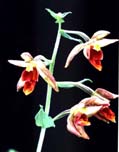|
Epipactis,
Eriochilus, Eulophia, Goodyera, Gymnadenia,
Habenaria, Herschelianthe, Neottianthe |
 |
Coloured signs |
Size of plants |
|
Epipactis |
|||
| mairei | dark red flowers | Cc | F 25,- |
| gigantea x royleyana | new hybrid | Do | 1y 5,- |
| royleyana | pretty flowers | Do | 2y 18,- |
| royleyana x Cephalanthera rubra | new interesting hybrid | Do | 1y 15,- |
| thunbergii | beautiful multicolour flowers | Cc | F 25,- |
|
Eriochilus |
|||
|
Eulophia |
|||
| meleagris | blueish flowers | Ee | 2y 10,- |
|
Goodyera |
|||
|
Gymnadenia |
|||
|
Habenaria |
|||
| longidenticulata | medium sized flowers, showy finged lip | He | F 25,- |
|
Hemipilia |
|||
|
Herschelianthe |
|||
|
Megastylis |
|||
| sp. |
very large orchids |
O |
1y 15,- |
|
Neottianthe |
|||
| Next Page |
Himantoglossum |
||||
|
E: ( Epipactis palustris, gigantea, veratifolia and hybrids
) Ee: ( Eulophia ) G: ( Goodyera) H: ( Herschelianthe ) Th: ( Thelymitra, Diuris ) Pe : ( Aminostigma, Poenorchis, Hemipilia ) |